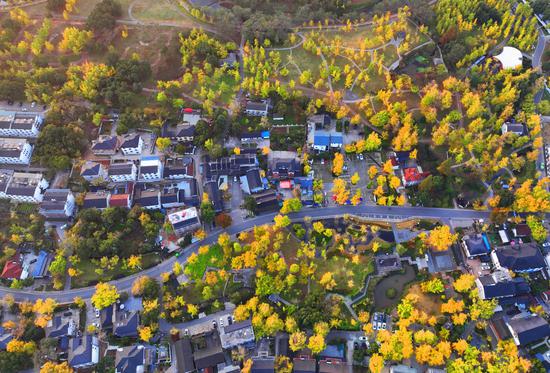Time-honored intangible cultural heritage thriving
The splendid Chinese civilization and long Chinese history were created by all ethnic groups of China. Meng Lulu, whose leather carving studio was listed as a municipal intangible cultural heritage in Urumqi, shared her stories.
Meng presented ECNS with a representative pocket in leather carving, of which the origin can be traced back more than 3,000 years, to a leather kettle with vortex pattern unearthed in Hami of Xinjiang, or the pocket pattern seen in the murals of Qiuci culture.
“The styles of pocket grew ever more brilliant as different cultures merged, exchanged, and communicated after the restoration. It also fits the modern aesthetics of beauty,” said Meng.
She hopes that the intangible cultural heritage can finally be handed down through her persistence.
Innovations stemming from new technologies and concepts provide Meng’s creation with more presentations. During the interview, she introduced that the AI and big data technologies are used to develop distinctive designs with modern aesthetic beauty.

Meng specifically mentioned the idea of active inheritance, which has incorporated making process of creative cultural products onto the video platform. “I hope these short videos can be good channels for presenting and promoting our culture”, Meng introduced.
“The techniques and culture behind the heritage are important to be known, especially those with distinctive Xinjiang features and regional stories”, Meng added.
Embracing prosperity amid new opportunities
Located in the core area of the Silk Road Economic Belt, Xinjiang is China’s window to the West. Speaking of the new opportunities brought by the Belt and Road Initiative (BRI), Sakib from Bangladesh
told ECNS that people from Bangladesh and China have a deep traditional friendship that allows the two countries to carry out cooperation in the fields of infrastructure, economy and trade, and culture and tourism.
“In the field of economy and trade, Xinjiang, as an important agricultural production base in China, is well known both at home and abroad for its specialty agricultural products, such as Xinjiang cotton, raisins and walnuts,” said the Bangladeshi, hoping that the two countries can cooperate in agricultural technology and trade in agricultural products to achieve mutual benefit and win-win results.
“In addition, the two countries can also strengthen exchanges and cooperation in the field of culture and tourism. Xinjiang has a rich ethnic culture, while Bangladesh also has a world cultural heritage and unique folk customs. Both sides can strengthen cultural exchanges, promote tourism development and enhance their friendship between the two countries.”

His idea was agreed by historian Ji, who said that as the region boasts the most land ports in China, 17 of Xinjiang’s 20 national first-class land ports are open all year round. Ji emphasized the significance of establishing efficient transportation channels to enhance Xinjiang's role as a "gateway." He further explained his expectation that more Chinese products could be transported worldwide from the Xinjiang ports.
The vast Xinjiang accommodates distinctive cultures of various ethnic groups. Here, different cultures merge, allowing diverse ethnic groups to prosper together.


















































 京公网安备 11010202009201号
京公网安备 11010202009201号